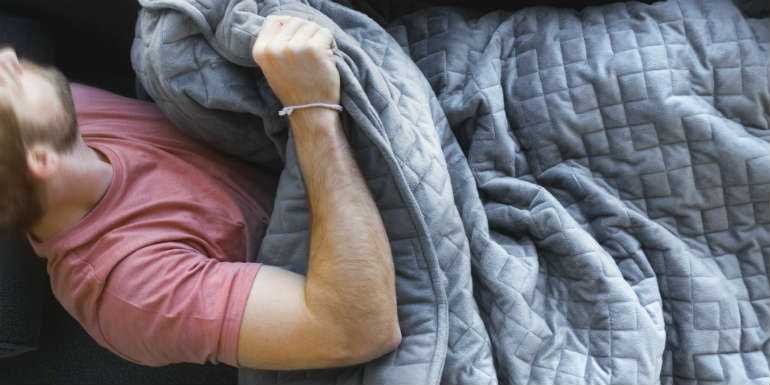Benefits of Weighted Blankets

In an effort to to avoid medicinal sleep aid that can be habit forming and have unpleasant side effects, many individuals suffering from insomnia are searching for natural ways to achieve a good night’s sleep. One of the post popular options today is the weighted blanket.
What are Weighted Blankets?
Weighted blankets have soared in popularity over the past year, with bold claims that they reduce anxiety, promote relaxation, and cure insomnia.
Weighted blankets have been around for several decades, typically used to treat autism in children and PTSD in adults. Lately, however, they have been discovered to greatly improve the lives of the general population by calming individuals at bedtime and reducing symptoms of insomnia.
Typically weighing between 15 and 30 pounds, weighted blankets are made up of quilted pockets containing glass beads, poly-pellets, or similarly weighted items that distribute the weight evenly throughout the blanket.
It is significantly heavier than a typical comforter or quilt and almost feels like firm, comforting hug for the person wrapped beneath it.
For summer months, there are special cooling blankets.
How do Weighted Blankets Work?
The body’s central nervous system is comprised of two main parts: the Sympathetic Nervous System (SNS) and the Parasympathetic Nervous System (PNS).
The SNS is the system that alerts the body to respond to stressful situations. Throughout the day, as we struggle to meet deadlines, deal with financial pressure, or fight heavy traffic, our SNS is on high alert.
The PNS has an opposite funcion - it calms the nerves, relaxes muscles, slows the heart rate, and increases circulation, and increases focus.
The firm and gentle pressure of a weighted blanket acts as a hug, promoting stillness and quietness of both mind and body, as well as the production of the “happy hormones”, dopamine and serotonin.
Benefits of Weighted Blankets

Insomnia
Chronic, long-term insomnia can have devastating effects on the body such as obesity, mood disturbances, high blood pressure, and an increased risk of stroke and heart disease.
Now, more than ever, we need help getting to sleep, and weighted blankets can be one of the most effective natural methods to ease the symptoms and effects of insomnia.
The weighted blanket’s evenly applied pressure stimulates the PNS to calm down the SNS, promoting relaxation and producing endorphins.
Since stress, anxiety, and general over-stimulation throughout the day are the most common contributors to insomnia, one of the natural benefits of weighted blankets is decreased insomnia symptoms and the increase the ability to fall asleep naturally and stay asleep longer.
Read more details in our Weighted Blankets for Better Sleep and Insomnia article.
Anxiety, Stress, and Calming
Some anxiety and stress is necessary in life. Without our Sympathetic Nervous System, we would never get out of bed for fear of being late to work, or drive defensively to keep ourselves safe in heavy traffic.
Often, hectic lives can result in a sensory overload that overwhelms the nervous system, triggering an onset of chronic anxiety and its symptoms.
By slowing the heart rate, increasing circulation, and stilling the body, Deep Touch Pressure gently forces the body to relax, thus calming the mind as well.
Weighted blankets - sometimes called stress blankets or calming blankets - can be a great way to naturally restore the hormonal balances needed in the brain to provide a good night’s sleep.
DTP can also soothe the over-stimulated sensory system, promoting a sense of calm.
Get to know more how weighted blankets can help easing Anxiety and Stress.
Autism
Autism Spectrum Disorder (ASD) is characterized by difficulty in communication, social interactions and repetitive thoughts or behaviors.
Unfortunately, individuals on the autism spectrum often get caught in a whirlwind of repetitive anxious thoughts or feelings, keeping the Sympathetic Nervous System in high alert.
This overstimulation often results in difficulty concentrating, increased anxiety in social situations, and trouble sleeping.
Deep Touch Pressure is widely accepted as a highly effective therapy for autistic individuals, and weighted blankets have been used by occupational therapists for years in autistic communities.
Weighted blankets can be a great tool for managing anxiety related symptoms for individuals on the autism spectrum with its use of tactile sensory input to calm the nervous system.
Head to our article about weighted blankets and autism to learn more.
ADHD
Individuals with ADHD may experience trouble focusing on school work or detail-oriented tasks, easily forget or lose their belongings, behave impulsively, take unnecessary risks, and sometimes struggle to get along with their peers.
ADHD is also aggravated by sensory overload. People with ADHD are unable to process the plethora of stimuli they encounter every day, and react with inappropriate responses. The calming effects of DTP help calm the nervous system, making weighted blankets a popular resource for ADHD management.
People with ADHD often find it helpful to wrap up in a weighted blanket when transitioning from times of physical activity to quiet work. Using a weighted blanket about 20 minutes before homework time or bedtime can greatly help individuals with ADHD make the transition more easily.
If interested in ADHD more in depth and check out the latest research read our article Weighted Blankets for ADHD.
Restless Leg Syndrome
Symptoms of RLS are usually most severe at night, or during periods of rest and inactivity.
Millions of Americans suffer from RLS and are seeking natural ways to ease their symptoms, especially the insomnia that often accompanies the disease.
Weighted blankets apply pressure evenly to the legs, essentially hugging them in a firm grasp and helping them to stay still.
The tactile input of DTP can also help calm the nerves in the legs that are over-reacting and wanting to move constantly. The Deep Touch Pressure used with weighted calming blankets can help relax the muscles, calm the mind, and improve symptoms of RLS, especially at night.
More details in our Weighted Blankets for Restless Leg Syndrome post.
Depression
Anxiety and depression often accompany one another, and depression is one of the most common mental health problems in the U.S.
Clinical depression is a complex issue that requires a medical diagnosis. Treatment can include drugs, therapy, or a combination of the two.
There are lifestyle changes that can naturally promote a sense of well being, as well.
One of the physiological causes of depression stems from low levels of serotonin. As one of the “happy hormones”, serotonin is a transmitter chemical that carries messages between nerves, including feelings of well-being and overall happiness.
Find out more about Depression and how Weighted Blankets may help.
PTSD
Post-Traumatic Stress Disorder is a chronic mental health illness that results from a traumatic event in an individual’s life.
PTSD is a debilitating condition that interferes with personal relationships, work, and other daily activities.
Deep Touch Pressure can offer some relief from stressful PTSD symptoms such as insomnia, nightmares, and general anxiety. Some therapists prescribe a weighted blanket to calm PTSD patients, help them feel safe, and sleep more soundly.
A weighted blanket can be a great relaxation technique to use along with medical help and group therapies.
Read more on How can Weighted Blankets help people with PTSD?
Further Diseases, Disorders and Situations
There are a number of other diseases, disorders and certain situatons and cases where weighted blankets can shine.
Here is a non inclusive list of these:
Do Weighted Blankets Really Work?
Many studies and consumer reviews have backed the claims that weighted blankets can help with a variety of anxiety and neurodevelopmental disorders.
A study published by the Journal of Occupational Therapy in Mental Health reported that 78% of anxiety patients preferred weighted blankets as a resource to manage anxiety instead of using drugs.
Deep Touch Pressure has been used by occupational therapists for decades to alleviate sensory triggered social and anxiety problems.
In recent years - especially the past several months - the amazing results from the use of weighted blankets have caused them to skyrocket in popularity.
